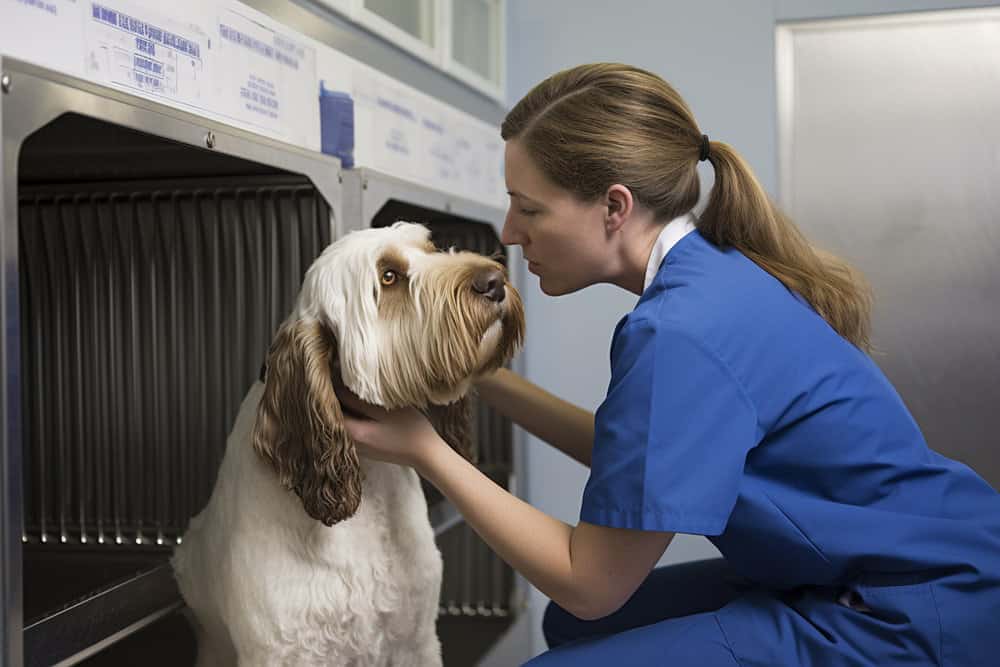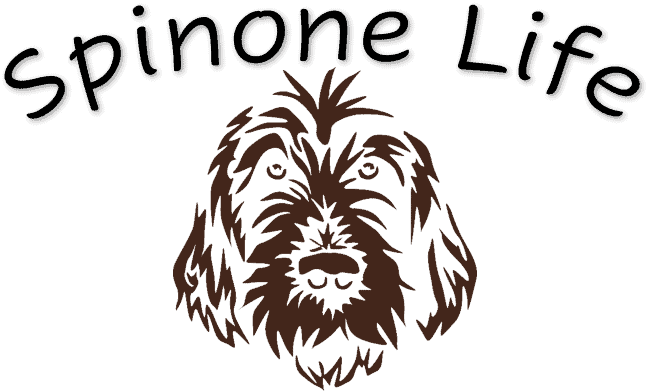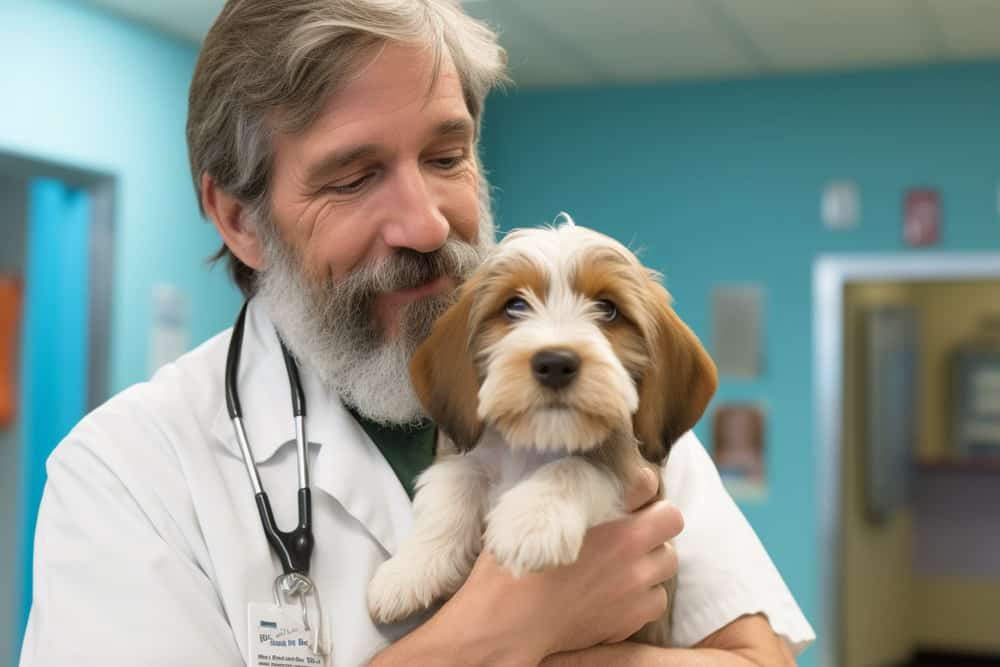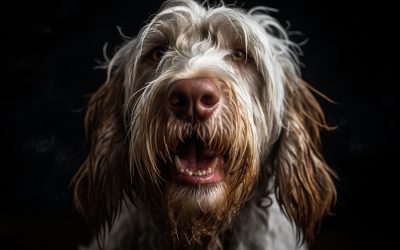All purebred dogs have the potential to develop genetic health problems, just as all people have the potential to inherit a particular disease. In addition, there are characteristics of the breed that can make them more prone to certain health problems.
The Spinone Italiano is healthy in general but can be susceptible to some genetic concerns such as canine hip dysplasia, ectropion (abnormality of the eyelids), epilepsy, and cerebellar ataxia (CHD), as well as more common health problems such as otitis externa (ear infections), and gastric torsion (bloat).
As with any dog breed, there are some health risks that are more prevalent among Spinoni than among other breeds. Here are five Spinone Italiano Health Issues to watch for.
Table of Contents
Canine Hip Dysplasia
One of the most common health issues with Spinoni Italiani is hip dysplasia. It is commonly seen in other large dog breeds. Hip dysplasia is a genetic disease that is a deformity of the hip that occurs during growth. The hip joint is a ball and socket joint. During growth, both the ball (the head of the femur, or thighbone) and the socket in the pelvis (acetabulum) must grow at equal rates. In hip dysplasia, this uniform growth during puppyhood does not occur. The result is laxity (looseness) of the joint, followed by degenerative joint disease (DJD) or osteoarthritis (OA), which is the body’s attempt to stabilize the loose hip joint.
Hip dysplasia is affected by factors such as diet, environment, exercise, growth rate, muscle mass, and hormones. As this disease is most commonly seen in large breed dogs (generally greater than 50 lbs or 22 kg), these puppies should be kept at a normal, lean weight during growth, rather than overfed and encouraged to grow “big.”
Advanced cases are characterized by joint inflammation, pain, stiffness, and degeneration of the bone itself. Dogs with symptomatic hip dysplasia will often have trouble performing simple tasks like climbing stairs or jumping onto a chair.
If you suspect your Spinone has hip dysplasia, your vet can use imaging technology to assess the severity of the dysplasia and can prescribe symptom relief. In severe cases, particularly among younger animals, surgery can correct the disorder.
Otitis Externa (ear infections)
Infection of the external ear canal (outer ear infection) is called otitis externa and is one of the most common types of infections seen in dogs. Some breeds, particularly those with large, floppy ears, like Spinoni Italiani, appear to be more prone to ear infections. However, ear infections may occur in any breed.
Ear infections are painful. Many dogs will shake their head and scratch their ears trying to relieve the discomfort. The ears often become red and inflamed and develop an offensive odor. A black or yellowish discharge commonly occurs. In chronic cases, the ears may appear crusty or thickened and the ear canals often become narrowed (stenotic) due to the chronic inflammation.
If you see your Spinone frequently shaking their head or scratching at their ears, there is a good chance they have an ear infection and you should get them to your veterinarian. Your veterinarian will thoroughly clean your dog’s ears using a medicated ear cleanser. Your vet may also prescribe an ear cleanser and a topical medication for you to use at home. In severe cases, your vet may prescribe oral antibiotics and anti-inflammatory medications.

Ectropion (abnormality of the eyelids)
Ectropion is an abnormality of the eyelids in which the lower eyelid ‘rolls’ outward or is everted. This causes the lower eyelids to appear droopy. Certain breeds have a higher incidence of ectropion than others. Congenital ectropion is the most commonly seen form of this condition affecting breeds like the Spinone Italiano, Cocker Spaniel, Saint Bernard, and Bloodhound.
Ectropion exposes the delicate conjunctival tissues that line the inner surface of the eyelids and cover the eyeball, causing drying of the tissues. This results in conjunctivitis. The surface of the eye or the cornea may also dry out, resulting in keratitis (corneal inflammation). All of these conditions are painful. Corneal damage can also result in corneal scarring, which can impair or obstruct vision. In most cases, both eyes are affected. Ectropion is usually diagnosed in dogs less than one year of age.
The treatment for mild ectropion generally consists of medical therapy, such as lubricating eye drops and ointments to prevent the cornea and conjunctiva from drying out. Ophthalmic antibiotics will be used to combat any corneal ulcers. If the condition is severe, surgical correction can be performed to shorten the eyelids.
Gastric Dilation and Volvulus (bloat)
Gastric Dilatation and Volvulus (GDV) is a life-threatening disorder most commonly seen in large, deep-chested dogs like the Spinone Italiano. However, any dog may be affected. In its early stage, the stomach fills with gas, causing a simple gastric dilatation or “bloat”. Sometimes, the condition progresses no further than bloat. A GDV is a progression of the bloat into a volvulus, in which the huge, gas-filled stomach twists upon itself so that both the entrance and exit of the stomach become blocked. This is a life-threatening emergency that requires surgery to correct.
The exact cause is still unknown. The condition is seen most commonly in large-breed dogs that eat or drink rapidly and then exercise vigorously. The Spinone Italiano and other large deep-chested dogs are at risk. Males are more likely to bloat than females. Neutering or spaying has no effect on risk.
If a dog has relatives (parents, siblings, or offspring) who have suffered from bloat, there is a higher chance he will develop bloat. These dogs should not be used for breeding.
GDV develops without warning and can progress very quickly. Recognizing the early signs is essential to increasing the chances your dog will survive.
Signs in the early stages of bloat can include:
- Restlessness
- Pacing
- Swollen or distended abdomen
- Painful abdomen
- Overall look of distress
- Retching or attempts to vomit with no success
- Excessive drooling
- Panting or rapid breathing
- Collapse/inability to stand
This is probably one of the most serious non-traumatic conditions seen in dogs. Immediate (within minutes to a few hours) veterinary attention is required to save the dog’s life.

Canine Epilepsy
Canine epilepsy is a common neurological disorder in dogs of all breeds and ages. It is characterized by seizures, which can range from mild twitching to more severe episodes with convulsions and loss of consciousness. Epilepsy is not curable, but it can be managed. It is important for pet owners to understand the condition and take steps to ensure the best quality of life for their pets.
The causes of canine epilepsy are not fully understood, but it is believed to be due to a combination of genetic and environmental factors. There may also be an underlying problem with the brain or nervous system that is causing the seizures. Canine epilepsy can be genetic, structural, or idiopathic (of unknown cause), and it’s important to accurately diagnose which type your dog has. Diagnosis of canine epilepsy involves a complete physical exam, blood work, and sometimes an MRI or CT scan. Treatment is usually with anticonvulsant medications, which can help reduce the frequency and severity of seizures.
Spinone Italiano owners should know that the breed has a higher prevalence of a severe form of epilepsy compared to the general dog population, according to research on canine idiopathic epilepsy. It was found that 5.3% of registered Spinoni in the UK had idiopathic epilepsy, which tends to have low remission rates and requires aggressive treatment for cluster seizures.
Diagnosing epilepsy in Spinone Italiano can be a complex process involving a range of tests and examinations to rule out other potential causes of seizures. Therefore, diagnosing idiopathic epilepsy in Spinone Italiano requires ruling out structural brain disease as well as metabolic or toxic causes of seizures. To diagnose the condition, veterinarians may recommend several diagnostic tests such as magnetic resonance imaging (MRI) and cerebrospinal fluid (CSF) analysis.
These tests help identify any underlying structural abnormalities that may be causing seizures. Additionally, bloodwork is often performed to check for any metabolic imbalances or toxin exposure that could potentially cause seizure activity. Finally, an electroencephalogram (EEG) can confirm the presence of abnormal electrical activity within the brain, which is characteristic of epilepsy.
It is important for Spinone owners to be aware of the signs of Canine Epilepsy, which can include the following:
- Seizures: These can be generalized or partial seizures, and can last from a few seconds to several minutes. During a seizure, the dog may fall to the ground, paddle its legs, lose consciousness, drool, and sometimes urinate or defecate.
- Confusion and disorientation: After a seizure, the dog may seem confused, disoriented, or dazed.
- Unusual behavior: Dogs with epilepsy may exhibit unusual behavior before, during, or after a seizure, such as biting at their own skin, pacing, or appearing restless.
- Loss of balance: During a seizure, the dog may lose its balance and fall over.
- Changes in mood or personality: Some dogs with epilepsy may experience changes in their mood or personality, such as increased aggression or anxiety.
If your pet is showing any of these signs, it is important to seek veterinary care immediately. Regular check-ups and monitoring can help ensure the best possible outcome for your pet. With proper care and monitoring, many dogs with canine epilepsy can still lead happy and healthy lives.
Spinone Italiano owners need to be aware of the breed’s predisposition to idiopathic epilepsy so they can take preventive measures or seek medical attention when necessary. Caring for a dog with epilepsy can be emotionally and physically taxing, especially when dealing with uncontrollable seizures or adverse effects from medication.
However, there are ways to improve the quality of life for epileptic dogs and their carers such as early diagnosis, effective treatment plans tailored to individual dogs’ needs, regular vet check-ups, and blood tests to monitor drug levels and liver function. You can learn more by reading Italian Spinone and Epilepsy: Everything You Need to Know.
Cerebellar Ataxia (neurological disease)
Cerebellar ataxia (CA) in the Italian Spinone is a serious neurological disease. In affected dogs, the cerebellum, which is part of the brain responsible for the coordination of motor movement in the body, becomes diseased. Affected dogs are born normal, but clinical signs, including the development of an unsteady gait, loss of coordination, and poor balance, usually appear in the first weeks or months of life. The disease is progressive; symptoms worsen during the first year of the dog’s life such that most dogs are euthanized before they are a year old. Sadly, there is no treatment for the disease.
Although there are many various types of Cerebellar Ataxia, there is only one Spinone-specific CA, ITPR1. Fortunately, a DNA test was developed by the Animal Health Trust (AHT) in the UK. Cerebellar Ataxia DNA tests are very easy to perform ( cheek swab) and have a 95-98% accuracy rate.
The Spinone Club of America strongly recommends that breeders complete Cerebellar Ataxia(CA) DNA testing on all breeding dogs. Through diligent DNA testing, carriers can be managed in a breeding program, as they are necessary for preserving and expanding the breed’s gene pool.
It is important to know that Cerebellar Ataxia in a Spinone is very rare. There have been only 23 documented cases of CA in the world. None of those occurred in the United States except for a test litter that was bred for research. Now that DNA testing is being done on breeding dogs, it is extremely unlikely that you would find a puppy born in the United States that could have CA.
Start With A Healthy Spinone
The best way to ensure that your Spinone puppy grows up to a healthy adult dog is to make sure you get them from a reputable breeder.
If you are looking for a puppy in the United States, a good place to start is to visit the website of the Spinone Club of America and choose a breeder who abides by the SCA’s Code of Conduct. The code of conduct prohibits the sale of puppies to pet stores or wholesalers and spells out the breeder’s responsibilities to the breed and buyers. The Spinone is an uncommon breed, so you may have a wait of six months or more before a puppy is available.
Also, we have put together a Spinone Italiano Breeder list that you can use to find a breeder in your area.
You might also consider an adult dog from a shelter or a rescue group. Many of the health problems in Spinone aren’t apparent in puppyhood, but by adopting an older dog, most of them can be ruled out. Also, Spinone can live 12 to 14 years, so an adult dog will still be a part of your family for a long time to come.
Regardless of which path you choose, make sure you have a good contract with the seller, shelter, or rescue group that spells out responsibilities on both sides. In states with “puppy lemon laws,” be sure you and the person you get the dog from both understand your rights and recourses.
Spinone Italiano Health Issues FAQs
What are some common health issues that Spinone Italianos may face?
Spinone Italianos may be prone to hip dysplasia, ear infections, Ectropion (abnormality of the eyelids), and Gastric Dilation and Volvulus (bloat).
How can I prevent my Spinone Italiano from developing health issues?
While genetics do play a role in a dog’s health, there are steps you can take to promote good health. This includes feeding a high-quality diet, providing regular exercise, maintaining a healthy weight, and scheduling regular veterinary checkups.
Can a Spinone Italiano be prone to allergies?
Yes, Spinone Italianos may develop allergies, which can lead to skin irritation and itchiness. Common allergens for dogs include certain foods, pollen, and flea bites.
Your vet can help determine the source of your dog’s allergies and recommend treatment options.
What is hip dysplasia, and how does it affect a Spinone Italiano?
Hip dysplasia is a genetic condition where the hip joint doesn’t develop properly, leading to arthritis and pain. Spinone Italianos may be prone to this condition, and it can worsen with age.
Symptoms include limping, difficulty rising, and reluctance to exercise. Treatment may include weight management, medication, or surgery.
Is cancer a common health issue for a Spinone Italiano?
Cancer can affect any breed, but Spinone Italianos may be more prone to certain types of cancer, such as lymphoma and mast cell tumors.
Early detection is key for successful treatment, so it’s important to schedule regular checkups with your vet and report any unusual lumps or bumps.





